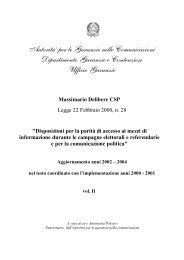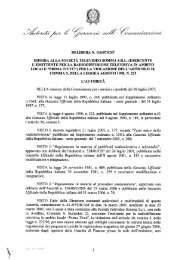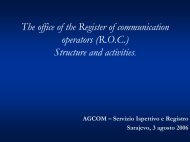Communications Regulatory Authority
Communications Regulatory Authority
Communications Regulatory Authority
You also want an ePaper? Increase the reach of your titles
YUMPU automatically turns print PDFs into web optimized ePapers that Google loves.
The supply of these services has also fuelled a discussion over the need to invest<br />
in access and transport infrastructure, in particular those in fibre optics. For example, in<br />
early 2006 the Mayor of Paris stated the intention to call a tender in the coming months<br />
for the creation of a fibre optics network to cover the city of Paris using Fibre-to-the-<br />
Home (FTTH) technology. The decision follows the initiative launched in Amsterdam<br />
that envisages the creation of a municipal fibre optics network reaching homes and<br />
businesses.<br />
In this context, France Télécom has stated that it wants to launch, in the coming<br />
months, an experimentation of the FTTH technology that will involve several thousand<br />
households in Paris and six cities in the Hauts de Seine area, for the purpose of meeting<br />
the demand which is expected to grow in the coming years. Other French operators are<br />
also implementing projects entailing the development of the fibre optics network;<br />
among these are the start-up CiteFibre and the cable operator Noos.<br />
Telefónica has also stated that it considers the ADSL+2 technology insufficient<br />
for the supply of advanced services. The need to transmit high-definition content and<br />
the simultaneous presence of various services that will use the broadband line at the<br />
same time should, in fact, require better performing connections.<br />
Although the transition toward new generation networks is a topic on the agenda<br />
of all European incumbent operators, the emphasis placed on the subject by the<br />
operators active in Eastern countries is much lower. This is because of the different<br />
market context in which they operate, characterized by a lower investment capacity<br />
(owing to the users’ lower spending possibilities and the lesser penetration of fixed<br />
network communications), a share of revenues from voice services that is still very high<br />
as compared to those of the more innovative services, and a limited number of<br />
competing companies (and therefore lower incentives for making investments in new<br />
areas). These factors also affect the offerings of integrated services. As things stand<br />
today, only two operators are presenting offerings to consumers of the triple-play type:<br />
the Slovenian operator Slovenije and the Estonian carrier Elion.<br />
Another front on which numerous product innovations are being introduced is<br />
that of the network connections within a specific environment (such as a household or<br />
office). There are various operators that are proposing to their users products that<br />
function as routers and modems, making it possible to connect a series of terminals to<br />
the broadband line: from computers to telephones, to consumer electronics devices. The<br />
purpose is to enable the customers, both residential and business, to make use of an<br />
increasingly broad range of additional services through broadband connections, in order<br />
to increase interest in such connections.<br />
Another topic concerning broadband which has attracted the interest of the<br />
sector operators and Authorities concerns the diffusion of WiMAX technology; this<br />
transmission technology makes it possible to reach, in wireless mode, average<br />
connection speeds of around 8-10 Mbps (up to a theoretical maximum of 75 Mbps) over<br />
an area that extends for up to about 50 km. There are numerous experiments being<br />
23















